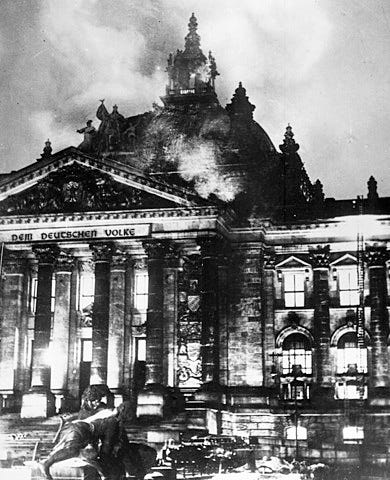Revisiting the Reichstag Fire, 90 years on
“Reichstag Fire” has become a synonym for an event that is used to justify some awful action that has nothing directly to do with the event itself.
(Photo: Wikipedia)
February 27 was the 90th anniversary of the original Reichstag Fire. This was the month after Hitler became German Chancellors, installed by conservative officials, appointed by German President (head of state) Paul von Hindenburg.
The supposed arsonist was a Dutchman, Marinus van der Lubbe…
On February 28, 1933, the day after the fire, Hitler’s dictatorship began with the enactment of a decree “for the Protection of the People and the State,” which dispensed with all constitutional protection of political, personal, and property rights. Though the ensuing elections still did not give the Nazis an outright majority, they were able to persuade the Reichstag to pass an Enabling Act (March 23) whereby all its legislative powers were transferred to the Reich Cabinet by a vote of 444 to 94, so sanctioning the dictatorship.
In the ensuing arson trial, van der Lubbe was convicted of treason; he was executed by guillotine in January 1934.1
It was widely assumed that Hitler’s own Nazi Party had set the the fire, conning Van der Lubbe into being the fall guy for them. Since it became such a key element in the initial establishment of Hitler’s dictatorship2 which would soon lay waste to large parts of Europe, it’s a plausible assumption.
As [Van der Lubbe’s] trial in Germany proceeded, a different kind of trial captured the public discourse. Willi Münzenberg, a German Communist [and head of propaganda for the German Communist Party], allied himself with other Communists to undertake an independent investigation of the fire. The combined research resulted in the publication of The Brown Book on the Reichstag Fire and Hitler Terror. It included early accounts of Nazi brutality, as well as an argument that van der Lubbe was a pawn of the Nazis. Hitler’s party members were the real criminals, the book argued, and they orchestrated the fire to consolidate political power. The book became a bestseller, translated into 24 languages and sold around Europe and the U.S.3
William Shirer’s very popular 1960 book The Rise and Fall of the Third Reich accepted the active participation of the Nazis in the setting of the fire. Münzenberg is now remembered primarily for his influential account of the Reichstag Fire. But as effective as he may have been as a Communist publicist, he broke with the Comintern (Communist International) in 1938 and publicly criticized the purge trials in the USSR and the German-Soviet Non-Aggression Pact (aka, the Hitler-Stalin Pact) in 1939. He died in France in 1940 in circumstances also never clarified. (His body was found with a cord around his throat4, so presumably he didn’t die by his own hand.)
The German government officially pardoned Van Der Lubbe in 2008 on the grounds that the trial was unfair.5 But the details of how the fire was set and whether Nazis were directly involved has never been fully clarified. Lorraine Boissoneault6 summarized the state of the research in 2017 as follows:
For historian Peter Black, a consultant for the United States Holocaust Memorial Museum, the one-man theory of van der Lubbe acting alone seemed correct until 2013, when new research came out with Benjamin Hett’s book, Burning the Reichstag. Hett wrote that, given the extent of the fire and the amount of time that would have been needed inside the Reichstag to set it, there was no way that van der Lubbe acted alone. Citing witness testimonies that became available after the fall of the Soviet Union, Hett argued that the Communists weren’t involved at all; rather, said Hett, the group of Nazis who investigated the fire and later discussed its causes with historians covered up Nazi involvement to evade war crimes prosecution.
Black does not entirely agree with Hett’s assessment, but he says that he is now convinced the one-man theory is false. “I would say that van der Lubbe could not have started that fire alone, based on the evidence that is now available,” he says. “It seems likely that the Nazis were involved. But you don’t have anyone who can say, yes, I saw the Nazis.”
Just this year, Van Der Lubbe’s body was exhumed.7 Examination of the remains could provide clues whether he had been drugged at the time of his trial. But it seems unlikely that could provide any definitive clues as to who participated in the setting of the fire itself.
Reichstag fire. Encyclopedia Britannica, 02/20/2023. <https://www.britannica.com/event/Reichstag-fire> (Accessed 2023-10-03).
De Jong, Alex (2023): How the Nazis Exploited the Reichstag Fire to Launch a Reign of Terror. Jacobin 02/27/2023. <https://jacobin.com/2023/02/reichstag-fire-anniversary-marinus-van-der-lubbe-kpd-spd-resistance> (Accessed: 2023-28-02).
Boissoneault, Lorraine (2017): The True Story of the Reichstag Fire and the Nazi Rise to Power. Smithsonian Magazine 02/21/2017. <https://www.smithsonianmag.com/history/true-story-reichstag-fire-and-nazis-rise-power-180962240/> (Accessed: 2023-28-02).
Bois, Marcel & Sonnenberg, Uwe (2021): Willi Münzenberg – derrote Medienmacher. Jacobin.de 07.Nov.2021. <https://jacobin.de/artikel/willi-munzenberg-der-rote-medienmacher-aiz-arbeiter-illustrierte-zeitung-neuer-deutscher-verlag/> (Accessed: 2023-28-02).
Connolly, Kate (2008): 75 years on, executed Reichstag arsonist finally wins pardon. The Guardian 01/12/2008. <https://www.theguardian.com/world/2008/jan/12/secondworldwar.germany> (Accessed: 2023-28-02). (Accessed: 2023-28-02).
Boissoneault (2017), op. cit.
Oltermann, Philip (2023): ‘Blind chance’ or plot? Exhumation may help solve puzzle of 1933 Reichstag blaze. The Guardian 02/26/2023. <https://www.theguardian.com/world/2023/feb/26/blind-chance-or-plot-exhumation-may-help-solve-puzzle-of-1933-reichstag-blaze> (Accessed: 2023-28-02).



